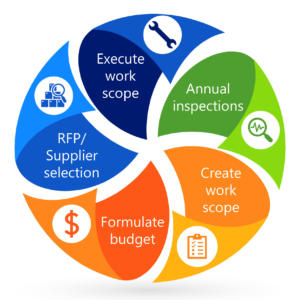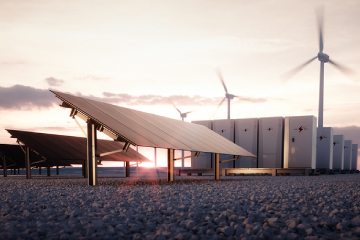- About UsAbout UsWe’re committed to providing future generations with the means to power their lives in the most economic, environmental and socially responsible ways possible.
- What We DoWhat We DoWe are a market-leading, independent power producer and service provider, delivering: wind (onshore and offshore), solar photovoltaic, storage, and electrical vehicle charging.
- Landowners
- Suppliers
- Projects
- Careers
- News
- Contact
Manage Your Blades, Optimize Your Investment

Proactive blade maintenance can maximize production while mitigating costly repairs
By Matt Sigala, Sr. Manager, Composite Repair Services
America is embracing the clean energy transition, and wind is playing a leading role. The nation’s more than 72,000 turbines represent more than 150 gigawatts (GW) of clean power, enough to serve the equivalent of 46 million homes.
Over the course of their 25-year operational lives, wind turbines – and in particular, their blades – are exposed to significant wear and tear from the elements, be that scorching sun, powerful gusts of wind, hail, or even lightning strikes. Regardless of the cause, even minor damage or irregularities can affect a blade’s performance, reducing clean energy production and impacting project revenue.
Having a proactive blade management program is therefore essential to protecting the value of these assets and ensuring that minor issues don’t develop into major, costly problems. Unfortunately, for many companies, blade management is still predominantly reactive. If inspections reveal damage, repairs are made, and the costs pile up.
With nearly 40 years of experience as owner-operators of wind projects across North America and a wind services portfolio of 11.5 GW, EDF Renewables is focused on preserving the value of our assets over the long term. Developing out of this experience is a comprehensive and cost-effective blade management program that is driven by a data-centric approach to identify and eliminate inefficiencies that might otherwise affect profitability and competitiveness.

Specifically, we’ve developed the in-house capacity to inspect, maintain, and repair the blades across our entire fleet, with impressive results – cutting the cost of our blade management campaign in half and saving millions of dollars annually.
What’s our secret? Terabytes of data paired with deep expertise and in-field experience. We’ve methodically built a database of the more than 7,200 individual blades in our fleet, closely tracking their condition with annual inspections.
Our in-house team of engineers and experts in composite materials leverages this data to produce assessments of blade damage that are much more sophisticated and nuanced than standard inspections.
In particular, we don’t simply accept inspection images at face value and look at them in isolation. Instead, our team reviews each image, compares it to images from prior years, and determines if the damage categorization assigned by the inspection provider is valid.
This additional layer of review is key to enabling the next step in the process, which is the development of a work scope that prioritizes which issues require immediate attention and which may be dealt with on a longer time horizon.
In addition to cost savings, our blade management system also provides the ability to review our fleet at multiple levels, be that from 10,000 feet or granularly at the level of individual blades. This in turn can provide valuable insights such as early forecasting of serial defects or understanding of the prevalence of blade-specific issues, and the information can then be presented in a dashboard for simple review and analysis.
The core benefit of this data-driven approach is that it leads to rational, economic decision making that is based on blade damage and defect analytics and includes external factors such as annual electricity production, the fleet’s current performance reliability, and the availability of staff with the necessary skills to effectively complete remediation campaigns. This is a fundamentally different approach from many inspection providers, whose sole focus is on detecting damage and assigning severity ratings to determine the appropriate repair scope without considering the bigger picture.
Thanks to our large, diverse operating fleet, we’ve worked with turbines from every major manufacturer, giving us experience to address nearly all issues and defects that can affect blade performance. Our in-house Composite Services team is fully prepared to handle any level of blade repair, from general maintenance and laminate repairs all the way to critical structure damage on shear webs and carbon fiber spar caps.
One of the keys to our success is that we draw on vast engineering expertise from our internal Performance and Reliability Engineering team and in-field composite teams. We’ve tracked more than 250,000 labor hours from a wide range of providers across all types of repairs and are uniquely equipped to evaluate potential suppliers, bids and estimates, schedule, costs, as well as assist with QA/QC of any suppliers selected to perform composite work.
As turbines age, proactive inspection and maintenance becomes increasingly important, particularly if replacement blades are no longer available. Likewise, we have observed blades on newer, larger turbines that are more susceptible to damage and require proactive maintenance from day one due to differing structural design and construction materials. In any case, finding issues early is critical to proper planning and controlling blade maintenance and repair costs.
We now offer our world-class blade management services to the wider market because we’re confident we can help wind asset owners significantly reduce the costs associated with inspecting, maintaining, and repairing blades, thereby helping to maximize the production and availability of your fleet while optimizing the value of your investment. As an operator-owner, you can rely on EDF Renewables to provide data-driven, expert guidance you can trust.
Post a Comment Cancel reply
- © 2025 EDF Renewables North America
- Privacy Policy
- AB 1305 Disclosure
- TCFD Report



Comments (1)
Congratulations Matt.
While EDF was one of the early adapters in recognizing the importance of a comprehensive blade maintenance program, we were still far enough behind the eight ball to experience the pain that can come from allowing blade damage to linger. I know very well the level of research and development that EDF has invested in their industry leading program and have no doubt that any customer choosing to partner with you will be immensely satisfied with that decision.